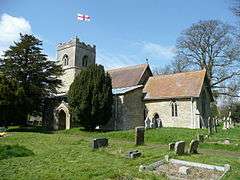Little Horwood
| Little Horwood | |
 St Nicholas' parish church |
|
 Little Horwood |
|
| Population | 434 (2011 Census)[1] |
|---|---|
| OS grid reference | SP7930 |
| Civil parish | Little Horwood |
| District | Aylesbury Vale |
| Shire county | Buckinghamshire |
| Region | South East |
| Country | England |
| Sovereign state | United Kingdom |
| Post town | Milton Keynes |
| Postcode district | MK17 |
| Dialling code | 01296 |
| Police | Thames Valley |
| Fire | Buckinghamshire |
| Ambulance | South Central |
| EU Parliament | South East England |
| UK Parliament | Buckingham |
|
|
Coordinates: 51°58′05″N 0°51′00″W / 51.968°N 0.850°W
Little Horwood is a village and civil parish in the Aylesbury Vale district of Buckinghamshire, England. The village is about four miles east-southeast of Buckingham and two miles northeast of Winslow.
The village toponym 'Horwood' is derived from the Old English for "dirty or muddy wood". The Anglo-Saxon Chronicle of 792 records the village as Horwudu.
The Church of England parish church of Saint Nicholas has a Perpendicular Gothic belltower built of large blocks of ashlar, the remainder of the church externally dates from the restoration of 1889 by the architect James Piers St Aubyn. This architect's work is not always viewed kindly today. His Victorian Gothicisation of so many churches and houses has been described in terms ranging from vandalism to ruthless. Little Horwood church was lucky as the interior survived relatively unscathed and the early 16th century wall paintings depicting the seven deadly sins survived as did the Jacobean pulpit and the Decorated Gothic chancel arch. The Tower has a ring of five bells with a tenor of 9cwt 2qtrs 22lbs, tuned to the note of G.
The manor of Little Horwood anciently belonged to the abbot and convent of St Albans, though it was seized by the Crown in the Dissolution of the Monasteries in the mid 16th century. It was later sold to George Villiers, 1st Duke of Buckingham who remodelled the manor house, which is now demolished.
One mile south east of the village is Horwood House. It should not be confused with Little Horwood Manor, which is a comparatively modern house.
Located between the village and near-by Great Horwood is RAF Little Horwood, a World War II airfield was constructed in 1940,[2] and was operational from 1942 to 1946.
Notable person
- Percy Thrower (1913–1988), the first television gardening presenter, was born at Horwood House, half a mile from the village.
References
- ↑ Neighbourhood Statistics 2011 Census, Accessed 3 February 2013
- ↑
External links
![]() Media related to Little Horwood at Wikimedia Commons
Media related to Little Horwood at Wikimedia Commons
